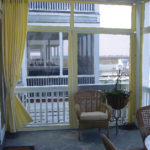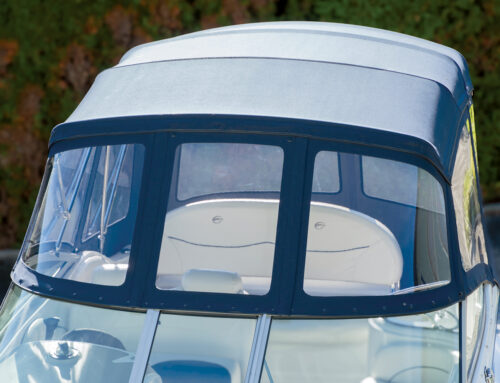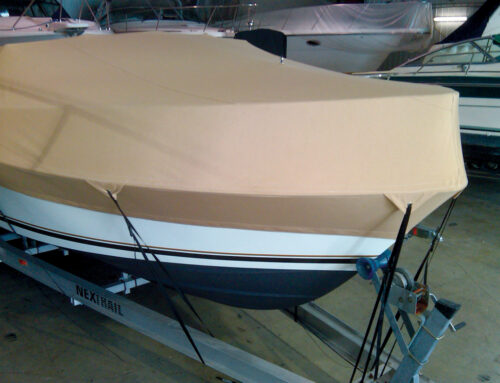Semi-rigid windows offer profitable opportunities
It didn’t take long for Jeri Perillo to get hooked on working with semi-rigid windows and enclosures. Perillo’s company, Custom Canvas of Charleston in North Charleston, S.C., installed its first semi-rigid enclosure four years ago on a boat at the request of Rainier Windows. Custom Canvas started fabricating the windows for Tiara yachts, and other types of boats followed.
Perillo’s customers instantly saw the advantages of these products: clarity, strength and abrasion resistance, to name a few. As a fabricator, Perillo benefits from the enclosures, too. “A big advantage is the amount of money you can make on them,” she says. “Plus, they always look so good on the boat when you’re done.”
Fabricators like Custom Canvas of Charleston have found new business opportunities in the market of semi-rigid windows and enclosures. By understanding the technical aspects and applications of these enclosures, fabricators can successfully work with these products, satisfy customers and increase their bottom lines.
The clear advantages of semi-rigid enclosure
In terms of the composition of semi-rigid marine enclosures, two types lead the pack: coated polycarbonate and uncoated acrylic. The two materials offer similar advantages. They tend to be resistant to scratching and yellowing, and most versions reduce nearly 100 percent of UV rays. Additionally, these semi-rigid enclosures feature insulating and sound-deadening properties. But perhaps the most compelling advantages to these enclosures, particularly when compared with soft vinyls, are their clearness, lack of distortion and longevity.
“Vinyl gets used and abused, and it starts to become cloudy,” says Buddy Sliva of Rainier Industries in Seattle, Wash., which manufactures both polycarbonate and acrylic semi-rigid enclosures. “People are looking for great clarity and something that lasts longer than a couple of years.”
-
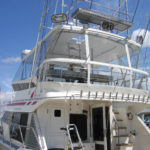
- This beautiful flybridge enclosure was created by Nautical X Inc., San Pedro, Calif., on a 50-foot Mickelson. The polycarbonate windows flip up and slide. By understanding the options and applications of semi-rigid products, fabricators can successfully meet customer expectations and increase their bottom lines.
Scott Knode, president of Ocean Clear Windows in Costa Mesa, Calif., sees similar advantages of semi-rigid structures over vinyls. “For instance, in the morning a vinyl or PVC enclosure looks good, but when the heat of the day comes on, you see waviness and sagging,” says Knode, whose company distributes specialized polycarbonate sheets to fabricators. “From time to time, when the windows are rolled, or if the fabricator is working in cold temperatures, that material can get brittle and crack.”
But as much as they are similar, polycarbonate and acrylic do have their differences. Polycarbonate, which typically features a specialized coating for marine use, is virtually unbreakable and shatterproof. According to Rainier, it offers 250 times the impact strength of glass. Coated polycarbonate is designed to be highly resistant to abrasion, but if scratches do occur, they can be minimized by using a mild polishing compound or carnauba wax.
Although acrylic products are not completely shatterproof, the new high-impact acrylics used for marine enclosures are very break resistant and have a tensile strength of 10,000 pounds, according to EZ2CY, a manufacturer of acrylic products based in Crownsville, Md. In addition, scratches can be buffed out of these uncoated acrylics.
“We like to use high-impact acrylic because we can make really tight bends with it without being concerned about the polycarbonate coating,” Sliva says.
Installation of semi-rigid windows also differs based on the material and how it’s manufactured. Ocean Clear produces a sewable polycarbonate. “It’s an important feature for our product and target market,” Knode says. “The fabricator can basically do the windows themselves, and it allows them to offer a top-quality product that their customer will be very pleased with.”
-
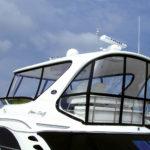
- Polycarbonate and acrylic products, like on this Sea Ray 480, have extended into non-marine uses, such as porch enclosures , patios, airplane and snowmobile windshields, and architectural enclosures, including decks and commercial tents. Fabricators find that the benefits of semi-rigid products outweight the challenges.
EZ2CY has been using the track-to-track system it developed since the company’s formation in 1989. The manufacturer licenses select companies to work with its products, allowing fabricators to have full responsibility over the installation of enclosures.
“When you’re doing the high-caliber boats, you have to oversee it from start to finish and have complete control of the process,” says Jeff Smith, technical engineer for EZ2CY. “If they’re installing an enclosure on a $6 million boat, and something’s not right, they can go back to their shop and do it. They’ve had it in their hands the whole time.”
Such a business model makes sense to Mike Erickson, president of Canvas Designers in Riviera Beach, Fla., a licensee of EZ2CY. “We’re better off having control of the quality and timing of installation,” he says. “I can get out five panel enclosures in a couple of days because we build in-house.”
Still, other fabricators prefer to partner with manufacturers in the fabrication of enclosures. Rainier, for one, receives patterns from fabricators, builds to their specifications, bonds the windows to the fabric using a stitchless, patented process and turns the product around within 10 to 14 days.
Custom Canvas of Charleston, which uses Rainier’s polycarbonate product, has found the relationship beneficial to her shop. “The advantage to us is one of time,” Perillo says. “We can finish a big product in much less fabrication time.”
Design and maintenance know-how
Perhaps the greatest obstacle in the fabrication of semi-rigid windows lies in the design. “You have one mindset working with the .040-gauge vinyl, where you can bend it around corners,” Perillo says. “I have to think differently when I’m designing the semi-rigid enclosures. I can’t roll them up, so I have to plan for how they will get air in the boat.”
Solutions to this conundrum include creating windows that slide like patio doors or flip-up and fasten to the roof. These solutions don’t always address the problem, but when there’s a will, there’s a way.
“When you don’t have a clearance to fasten a window overhead, or there’s an instrument box in the way, you have to come up with other designs,” Erickson says. “Sometimes they stay fixed a lot more on radiuses, or we can put hinges in them to fold half the panel. You find other design elements that allow you to create different methods for opening than the flexible-window scenarios.”
Despite the design challenges, fabricators have found that the benefits of working with semi-rigid enclosures far outweigh any potential pitfalls. In addition to clarity, abrasion resistance and UV protection, a big selling point for both fabricators and consumers is the enclosures’ low-maintenance care and cleaning.
Manufacturers and fabricators of both the coated polycarbonate and acrylic recommend a microfiber or cotton cloth, mild dishwashing soap and lots of water as the ideal cleaning solution. A plastic cleaner and polish can also be used. To buff out scratches on the acrylics, fabricators suggest products such as 3M’s Finesse-it. Regardless of which type of semi-rigid enclosure a boat implements, common sense leads the way in terms of care and maintenance.
“As with any plastic, it’s important to thoroughly rinse salt and debris before cleaning,” Knode advises. “The more you keep the dirt off, the longer the enclosure will last.”
Expanding applications
The applications of semi-rigid windows continue to expand with the product’s increasing popularity. “It used to be strictly the high-end of the business,” Erickson says. “The majority of where we’re putting these things is sport fishing boats 40 feet or larger, but as people find value in it, it’s expanding more into all boats. We’ve done T-top panels, 25-footers, even dodgers on sailboats.”
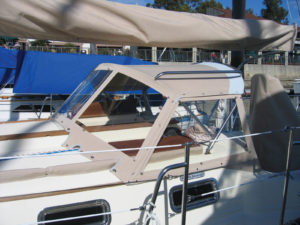
The dodger on this 31-foot Pacific Seacraft is made from a polycarbonate distributed by Ocean Clear Windows. Semi-rigid enclosures typically cost consumers twice as much as vinyl alternatives, but according to manufacturers of semi-rigid products, they will last three to four times longer.
Polycarbonate and acrylic enclosures have extended into non-marina uses, as well. Custom Canvas of Charleston has created porch enclosures and an airplane windshield, while Ocean Clear has put its product on patios, golf carts and snowmobiles. Rainier has used its polycarbonate product on architectural enclosures, such as restaurants and house decks, along with high-end commercial tents.
Word-of-mouth has been a highly effective sales tool for fabricators. “Because semi-rigid enclosures are fairly new to the industry, a fabricator will do a job in a local marina and then will get more jobs because they have a reference from customers,” Knode says. “In this case, seeing truly is believing.”
Sliva agrees. “The key is to get an influencer in a marina. There’s always one guy who’s kind of the big talker who’s always on his boat. Once he’s hooked, he can’t wait to show it off to all his friends. It goes down the dock and it becomes the ‘Me, too’ type of scenario.”
One sticking point for a handful of fabricators has been price. Though semi-rigid enclosures will typically cost the consumer twice as much as the soft-vinyl alternative, the product will last three or four times longer, according to Sliva. However, if a fabricator can get past the hurdle of selling a higher-priced product and have the marina “influencers” on their side, the rewards will be plentiful.
“Some fabricators are embarrassed to tell customers of costs,” Perillo says. “I think if you approach people about what a great product this is, you can overcome the price issue. It’s definitely something fabricators should pursue because it will ultimately increase their bottom line.”
Holly O’Dell is a freelance writer based in southern California.
 TEXTILES.ORG
TEXTILES.ORG 



